By SONG Jianlan
The return of the first-ever samples from the farside of the Moon does not mean the ending of the Chang’e-6 mission. Instead, it hails the real exploration into a once inaccessible part of the satellite.
A high-profile event in 2024 for the science community and the public as well, the Chang’e-6 (CE-6) mission repeatedly hit headlines from March to June 2024. First in March 2024, the launching of the Queqiao-2, a relay satellite for communication support necessary for farside tasks, heralded the journey. On June 2, 2024, the lander-ascender complex of CE-6 successfully touched down in the South Pole-Aitken (SPA) basin on the lunar farside to scoop, drill and collect samples; later, on June 25, 2024, the CE-6 returner brought the 1,935.3 grams of samples home safe and sound. For the first time ever, human beings obtained samples from the lunar farside, marking a significant milestone in lunar exploration.
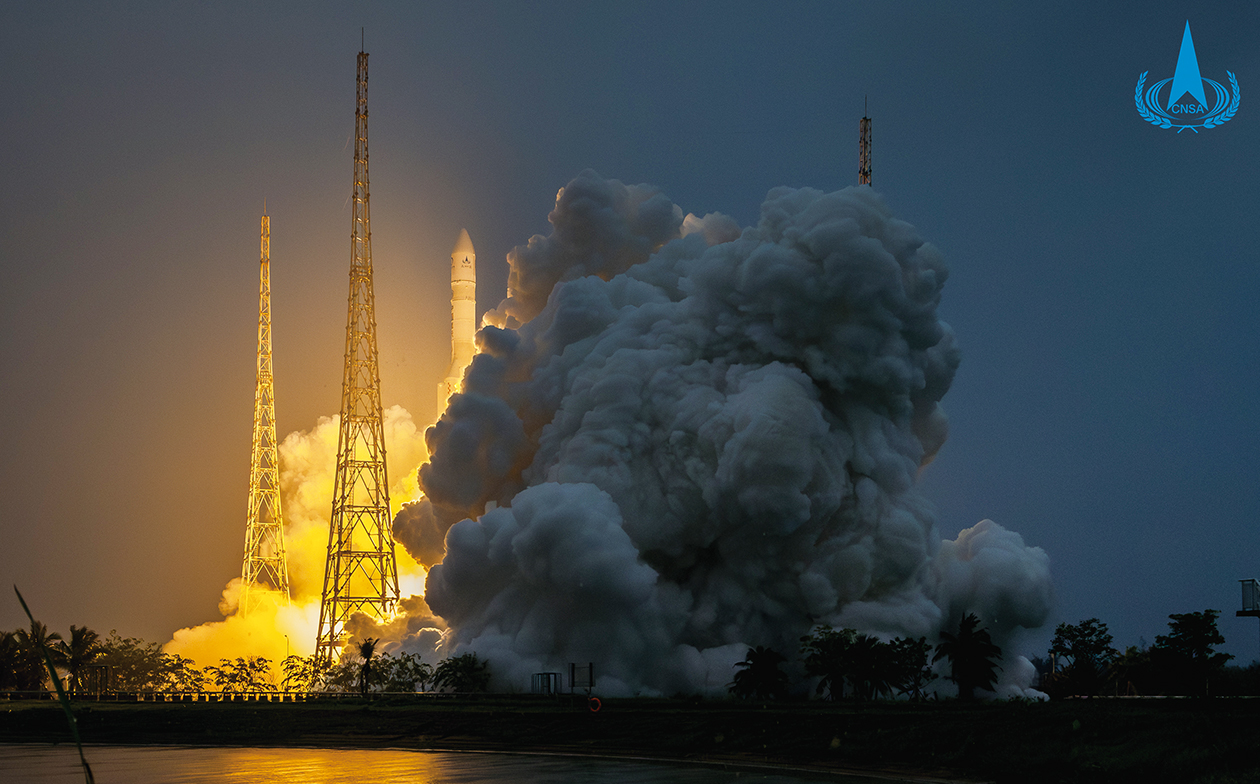
Chang’e-6 taking off from the launching pad. (Image: CNSA)
Major Technical Breakthroughs
In its 53-day journey, CE-6 made a series of technical breakthroughs that secured the successful completion of its tasks on the lunar farside, in the absence of timely human interference or instruction. Given the average distance measuring 38.4 thousand kilometers between the Earth and the Moon, and the time hence needed for electromagnetic signals to travel to and from the Moon, the Earth and the relay satellite, real-time instruction would be impossible.
Among these breakthroughs, three are particularly worthy of mentioning. First, the unconventional orbit design and control technology adopted in the mission to make possible the soft landing on the lunar farside. Yes, before CE-6, Chang’e-4 (CE-4) had already performed a successful soft landing on the farside; but CE-6, as a backup satellite for CE-5, was originally designed for landing from the nearside just as what CE-5 did. This means it had to overcome the inherent problems to accomplish a task beyond design. An orbit reverse to that of CE-5 (hence against the rotation of the Moon) and the corresponding controlling technology made this possible. Second, the technologies for smart robotic sampling on this part of lunar surface. Due to the special location, the sample collection was challenging without human interference. Third, the set of technologies helped the CE-6 ascender successfully take off from the rugged surface and dock onto the orbiter-returner complex staying in-orbit. This directly paved the way for the successful flight home and the return of the invaluable samples.
The mission, culminated with the first-ever return of samples from the lunar farside, seems to have completed with a bumper harvest of honors. However, for scientists, the return of samples just means the beginning of a real science exploration. The returned samples provide the well-awaited opportunities to further understand some long-sought-after questions about our closest neighbor in the cosmos, and in turn might further inspire our understanding of the Earth itself, and even the solar system. This quest, has actually prompted scientists to initiate the Chang’e Program itself.

The ascender of Chang’e-6 successfully docks onto the orbiter. (Image: CNSA)
Filling the Gap in Sampling
Based on the spatial distribution of thorium, an incompatible element, on the Moon’s surface, the lunar surface can be divided into three very distinct geochemical provinces. These provinces are called the Procellarum KREEP1 Terrane (PKT), the Feldspathic Highland Terrane (FHT), and the South Pole-Aitken Terrane (SPAT), respectively. For studies on the former two provinces, scientists have obtained lunar samples collected from the nearside by the Apollo, Luna, and CE-5 missions; however, before CE-6, no sample for the SPAT was available. The CE-6 samples have come to fill the gap.
Based on analyses on samples from the nearside of the Moon, scientists have derived a series of hypotheses, significantly advancing planetary science. Now with the CE-6 samples, scientists have the opportunities to examine whether these hypotheses also apply to the farside.
The months following the samples’ return saw scientists working hard analyzing the samples. So far, they have made a series of discoveries, revealing the samples’ compositions, the sampling site’s age, and updating our knowledge of the Moon’s volcanic activities and its ancient magnetic field.
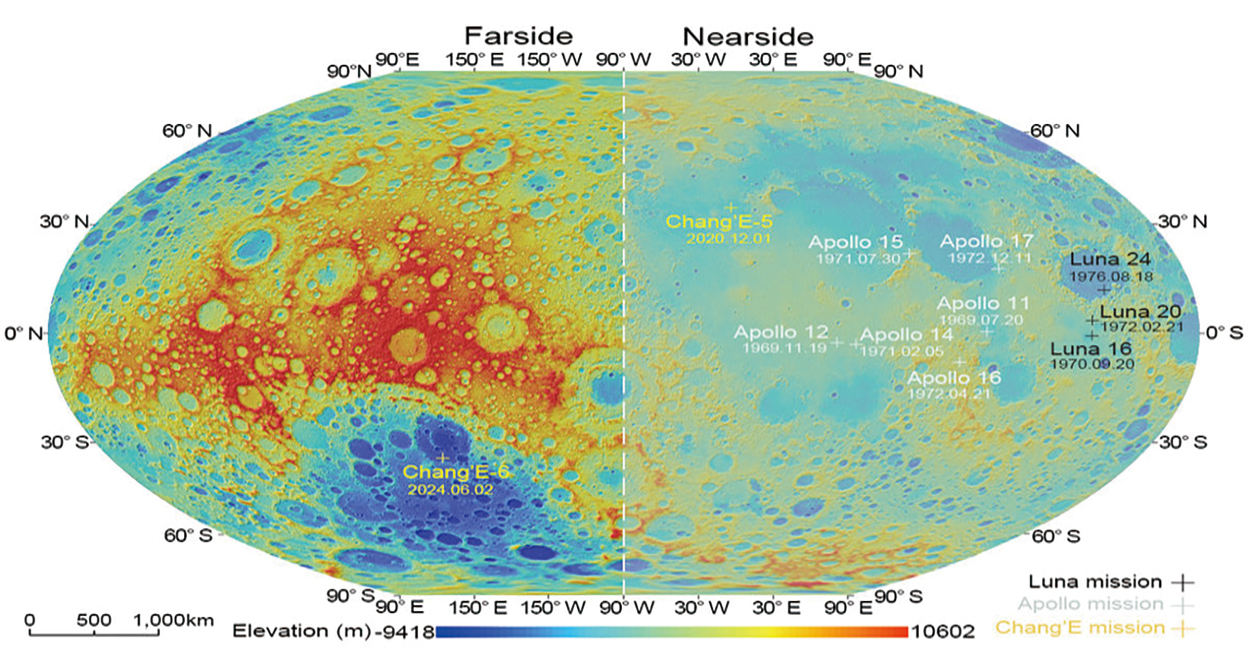
Illustration of the landing sites of Chang’e Missions (China), Apollo Missions (USA), and Luna Missions (Soviet Union). Ten out of the 11 sites are located on the near side of the Moon. (Image by NAOC)
Understanding Composition of CE-6 Samples
The sampling site is located on the brim of the SPA basin near to the south pole of the farside. This basin represents the biggest, the deepest and the most ancient impact crater known on the Moon. According to Prof. LI Chunlai, vice principal designer of CE-6 and a researcher at the National Astronomical Observatories (NAOC), Chinese Academy of Sciences (CAS), samples from the farside can help scientists explore several key aspects of the Moon: the early evolution of the Moon, the variability of volcanic activities between the nearside and the farside, the impact history of the inner solar system, the record of galactic activity preserved in the lunar weathering layer, the lunar magnetic field and its anomalies and duration, and the composition and structure of the lunar crust and mantle. Findings obtained in sample analyses could even inspire new concepts and theories regarding the origin and evolution of the Moon, and refine its use as an interpretive paradigm for the evolution of the terrestrial planets.
LI’s team and cooperators analyzed the physical, mineralogical, petrographic and geochemical properties of CE-6 samples, and reported their discoveries in National Science Review on September 16, 2024. This marked the first results from CE-6 sample analyses. They found that the samples reflect a mixture of “local” mare basalt material and “foreign” non-mare material.
The rock fragments in the CE-6 samples, as the team found, are mainly basalts, breccias and agglutinates. Among them, the local basalts contain little titanium or aluminum elements. As for the soils, are mostly a mixture of local basalts and non-basaltic ejecta materials. The primary constituent minerals are plagioclase, pyroxene and ilmenite, with very low olivine abundance.
Comparing with lunar samples from the near side, the CE-6 soil samples are much looser in thickness, and higher in aluminum and calcium contents, with grain sizes clustering in bimodal distribution. In them, the team found different lithologic components, including basalts, breccia, bindstone, glass and light-colored rock debris.
“These local mare basalts document the volcanic history of lunar farside, while the non-basaltic fragments may offer critical insights into the lunar highland crust, South Pole-Aitken impact melts, and potentially the deep lunar mantle, making these samples highly significant for scientific research,” said LI.
Revealing Lunar Farside Volcanism at 2.8 Ga
CE-6 samples can help scientists explore a problem puzzling them for a long time, the “hemispheric dichotomy of the Moon” — the great imbalance between the nearside and the farside. This imbalance manifests in many aspects, including basalt distribution, terrain variation, crustal thickness, and the concentrations of chemical elements, including the signature elements collectively named “KREEP” comprised of potassium, rare earth elements and phosphorus.
Stunning imbalance is visible in the distribution of lunar basalts. Resulting from solidified lava that erupted from the mantle in ancient volcanic activities, basalts cover about 18% of the global lunar surface. Interestingly, however, 93% of them have deposited on the near side, leaving only about 7% on the other. To understand how this asymmetry has come into being, we need to know how the volcanic activities have evolved throughout the life of the Moon.
Previously, nearside samples brought back by Apollo missions had supported the hypothesis that the Moon experienced an extensive melting process in its early formation. When cooling down, an egg-like structure similar to that of the Earth took shape: the lighter matter floated to the surface and solidified to form a rocky crust, while the relatively heavier part stayed at the intermediate sphere to form the mantle, overlying the hot metallic core at the center. The hot core could have kept pumping magma from the depth of the structure to drive volcanism.
Combining samples returned by Apollo missions and CE-5, scientists reconstructed a model that volcanic activities on the Moon could be traced back to at least 4 billion years ago, and continued on to some point around 2 billion years ago. On the other hand, volcanic glass beads found in CE-5 samples suggested that small-scale volcanic activities could have occurred about 120 million years ago on the near side. Whether or not the farside had experienced such prolonged volcanism remained unclear, however. Chronology established with crater counting suggests that the farside also experienced a volcanism similar to the nearside, but for a long time, no sample from this part was available to verify the theory.
Now CE-6 samples have come to fill the gap. The basalts record the primordial abundances of certain radioactive isotopes from the lava. When time elapses, these isotopes decay into other isotopes or elements at a certain rate. Therefore, by accurately measuring the relative abundance of the original and resultant isotopes or elements, one can infer the time taken for the decay to arrive at this ratio. The time consumption represents the age of the examined basalt, corresponding to the time when the lava erupted from the depth of the mantle.
Based on their independent analyses of the CE-6 samples, two teams from CAS simultaneously reported their discoveries about volcanism on the farside in Nature and Science.
Led by Prof. LI Qiuli from the CAS Institute of Geology and Geophysics (IGG), a research team analyzed two sets of samples retrieved by CE-6, and revealed in Nature on November 15, 2024 two episodes of volcanic activities on the farside. They performed lead-lead dating of the minerals in 108 basaltic fragments, and found that the most ancient piece among them, rich in aluminum element, represents an episode of volcanic activities dated at about 4.2 billion years ago. However, according to the authors, this fragment could be “alien” to this site — it might have been splashed to the Apollo basin within the SPA basin via some mechanism from other region. The other 107 fragments dated at a statistically consistent eruption age — about 2.8 billion years ago. This surprisingly young age had never been observed on the nearside of the Moon.
The IGG team concluded that the younger fragments represent the dominant episode of volcanism in this area. Its age roughly coincides with the one (3.07 to 2.40 billion years ago) predicted by the above-mentioned cratering chronology model, implying that the latter also applies to the lunar farside. Therefore, the accurate radioisotopic dating data obtained from CE-6 samples can also be used to calibrate the cratering chronology model, filling the missing points on its age curve.
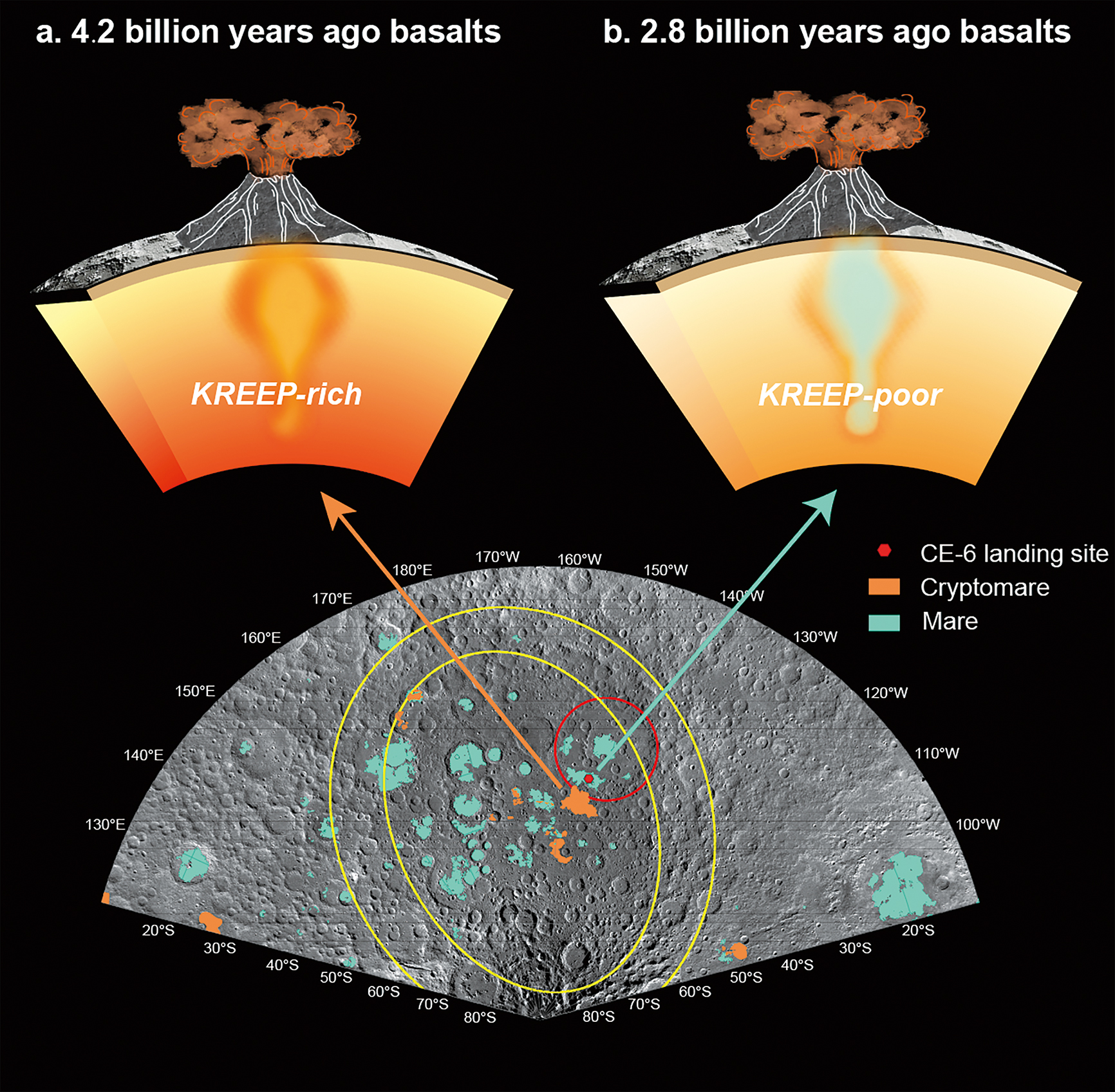
Based on analyses of samples returned by Chang’e-6 (CE-6) mission from the far side of the Moon, CAS scientists revealed two episodes of volcanic activities on the lunar farside, one occurring about 4.2 billion years ago, another 2.8 billion years ago. The younger one represents the dominant episode of volcanism for the sampling site, the South Pole-Aitken basin. Lunar volcanism occurring at this young age had never been revealed before. The research demonstrates that on the lunar farside, volcanism persisted for at least 1.4 billion years since about 4.2 billion years ago. (Image by IGG)
The interval between the two episodes, the team stated, indicates that volcanism on the lunar farside could have persisted for at least 1.4 billion years. Via radioisotopic analysis of the mineral components, the team also obtained the initial uranium/lead ratio of the mantle sources for two episodes of basalts. The extremely low uranium/lead ratio indicates that the mantle of this area could have depleted of “fuels”, namely heat-producing radioactive elements. The samples also indicate an extremely low concentration of KREEP elements. The KREEP elements, according to a formation model of the Moon, represent the incompatible elements in ancient lunar mantle that clustered between the upper mantle and the rocky crust during the cooling process. As an indicator, depletion of KREEP might mark a late stage of volcanism where the mantle had become poor in heat-producing elements and hence not very active.
On the same day, another team from the CAS Guangzhou Institute of Geochemistry (GIG) reported a dating result consistent to the IGG one. Led by CAS Member Prof. XU Yigang, the GIG team used both lead-lead and rubidium-strontium radioisotope dating to examine the low-titanium basalt in a CE-6 sample. On November 15, they reported online in Science that the basalt was formed at a time about 2.83 billion years ago. “We interpret this as the age of volcanism in SPA and incorporate it into lunar crater chronology,” said the team. In terms of KREEP abundance, they also found that this basalt might have originated from a lunar mantle depleted in KREEP component.
The revealed volcanism occurring about 2.8 billion years ago filled the temporal gap between 3.2 to 2 billion years ago in the cratering chronology of the Moon, and demonstrated that after a radical drop, the cratering on the Moon arrived at a relatively stable flux at this time.
Evolution of Ancient Lunar Magnetic Field
CE-6 samples also provide a unique opportunity to investigate the paleomagnetic field of the Moon, as well as its possible power sources. This is essential for understanding the inner structure, thermal history and surface environment of this satellite, according to Dr. CAI Shuhui, a researcher at IGG.
The Moon does not possess a global dipole magnetic field nowadays. However, previous satellite observations and in situ investigations both indicate widespread magnetization of the lunar crust. This means, in ancient time, there existed a lunar magnetic field. What mechanism had produced it? And how come it disappeared? Answers to these questions can help us explore some fundamental issues in planetary science, including those relevant to our own habitat, the Earth.
Any charged matter in movement can produce a magnetic field. Specifically, for the Moon, scientists have come up with some theories about the possible mechanisms that might have driven the ancient magnetic field there. A possible mechanism is a global dynamo: The rotation of the conductive metallic core could have generated a magnetic field for the Moon. Another possible driver could be the transient field generated by the impact events. Fierce impacts from alien objects may remagnetize rapid-cooling rocks and let them record such impact-generated field.
Based on the paleomagnetic studies of lunar samples returned by the Apollo missions, scientists had reconstructed a model of the overall evolution of ancient lunar dynamo field: About 4.2 to 3.5 billion years ago, the Moon might have possessed an active dynamo that generated a strong magnetic field, up to dozens of microteslas (as a comparison, the field strength on the Earth’s surface varies from 25 to 30 microteslas at the equator, and about 60 to 70 near the poles). This magnetic field receded by one order of magnitude about 3.1 billion years ago, down to merely several microteslas. It maintained at a weak intensity until the “dynamo” totally ceased to work at some time about 1 billion year ago.
This overall picture, however, lack direct constraints from the farside; on the other hand, before CE-6, the paleomagnetic data available were mainly from 3.0 billion years ago, with merely sporadic data reflecting the evolution thereafter. The large gaps in both temporal and spatial dimensions have led to ambiguity and controversy in the duration, geometry and driving power of the lunar magnetic field.
Working with NAOC colleagues, a team from IGG led by CAS Member Prof. ZHU Rixiang and Dr. CAI Shuhui accurately measured and analyzed the paleomagnetism of four CE-6 basalt samples, and revealed a surprising resurgence of paleomagnetism occurring around 2.8 billion years ago. This, has shed new light on the variation and powering mechanism of the paleomagnetic field of the Moon, challenging the previous model of lunar magnetic evolution.
The previous model suggested that the drastic drop in lunar magnetic strength occurring 3.1 billion years ago implied that the dynamo turned into a low-energy state at that time, and stayed in this low-energy state for about 2 billion years before an entire termination. During this low-energy state, the magnetic field might have been mainly driven by the crystallization of the lunar inner core, and the precession of the Moon.
The team reported online in Nature on December 19, 2024 that the recovered paleointenisty varies between 5 to 21 microteslas, much stronger than the intensities for this age predicted by the previous hypothesis. Given that the paleomagnetism might have resulted from different mechanisms or processes on the Moon, and might also have been contaminated by the Earth’s own magnetic field after the return, the team made great efforts to differentiate the different components of the magnetic signals in the samples. The team prudently evaluated possible contaminations with comprehensive analysis to identify and remove the irrelevant magnetism. In so doing, they ruled out the influences from the crustal magnetic anomalies of SPA basin, and those from the Earth’s magnetic field. They also examined the minerals in the samples with computed tomography (CT), scanning electron microscopy (SEM), Raman spectroscopy and optical microscopy analyses to estimate the effects from their possible impact history. Based on the fact that the basalt clasts maintained original volcanic mineral crystalline structures with no obvious fracture, combining their not-too-fast cooling rate, the team assumed that the samples had recorded negligible magnetism from their past bumping with alien objects.
In the end, ruling out these possible contaminations, the team concluded that the surprisingly strong paleomagnetism recovered from the samples is likely to have come from a global dynamo field of the Moon.
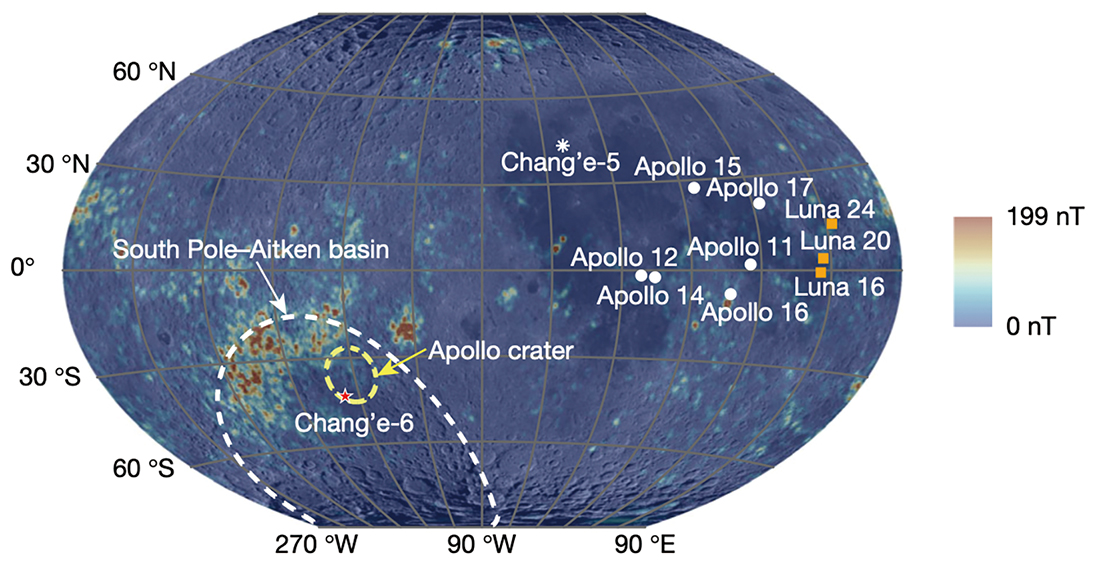
Magnetic anomalies on the lunar surface, put along with landing sites of different lunar-exploring missions. (Image by IGG)
To find out what could have generated this magnetic field, the team explored simulation results of different types of dynamos as possible power sources for the paleointensities of CE-6 samples. They found that the measurements aligned the best with a dynamo originated from a basal magma ocean, which is proposed to have been generated by the emplacement of a radioactive heat-producing and metalliferous layer at the core-mantle boundary during the lunar mantle overturn.
The result implies that very likely 2.8 billion years ago the dynamo was still working at a modestly powerful state. Still, considering the uncertainty in simulation parameters, the team admitted that relative movement between the different lunar spheres caused by the Moon’s precession could also be a possible origin of the magnetic field. Probably, it had joined with the inner core crystallization to drive the paleomagnetic field, with other mechanisms working in complement. Given the uncertainty in both the basal magma ocean model and the precession model, the exact power sources of the dynamo are still pending for determination, the team warned.
The team reckoned that this reinforcement might imply a re-activation of the once declined dynamo, or some change in the magnetic field’s driving mechanism. Their further analyses revealed that during the period between about 3.5 to 2.8 billion years ago, the lunar dynamo might have experienced an instable time, which led to visible fluctuations in the magnetic field.
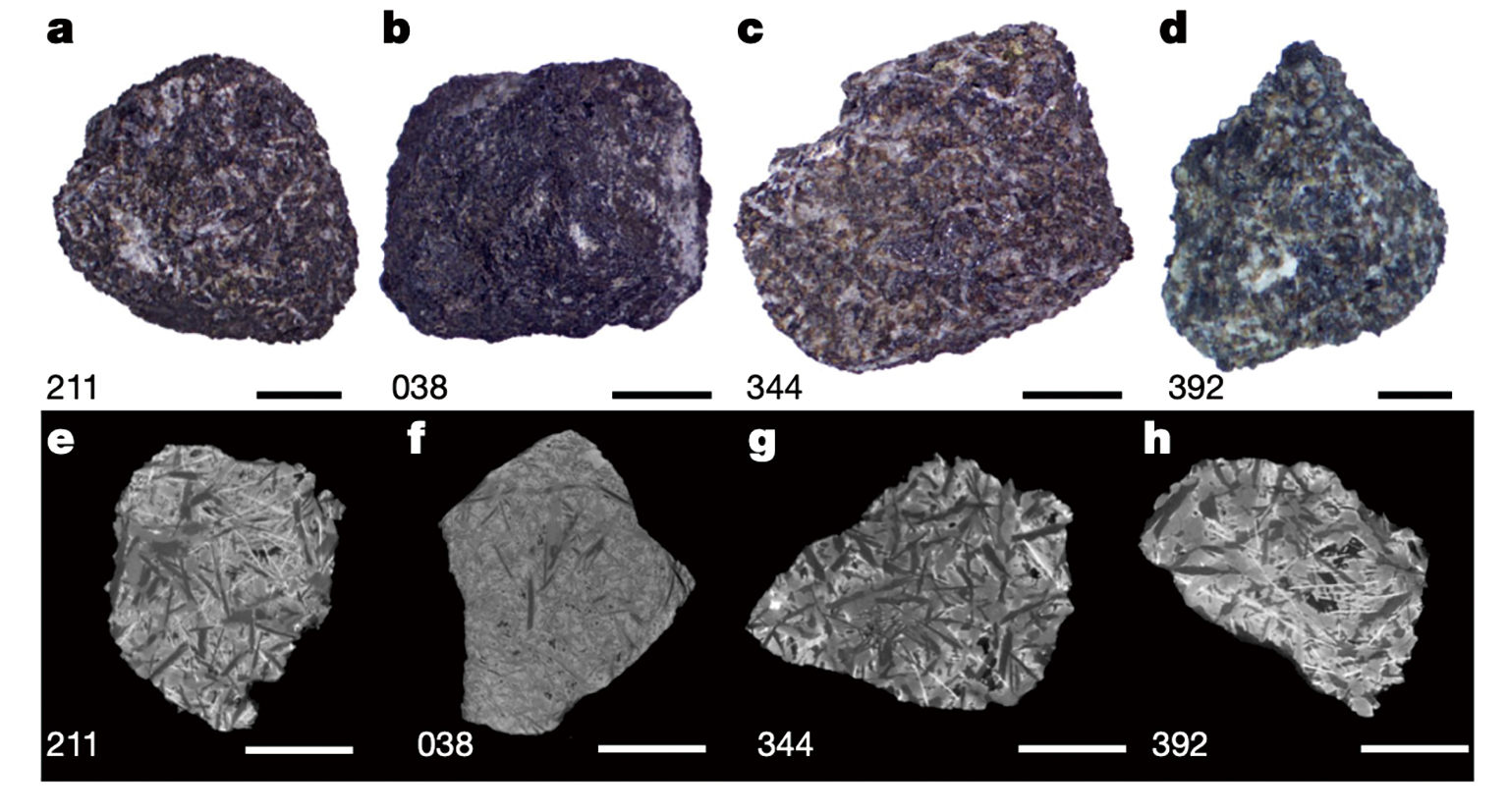
Stereomicroscope photos (a–d) and CT transects (e–h) of the basalt clasts investigated in the study. Given that the crystals exhibit little modification from impacts, the team ruled out the influence of acquired shock remanent magnetization in the recovered paleointensity. (Image: IGG)
Somewhat a coincidence, on January 1, just less than two weeks after the Nature paper, CAI’s group reported in Science Advances another discovery about the magnetic evolution of the Moon — based on their analyses of CE-5 samples. They found that about 2 billion years ago, the Moon still had a weak dynamo magnetic field of approximately 2 to 4 microteslas. This further filled the temporal gap with important constraints in the midstage of the Moon. Combining the results from both CE-5 and CE-6 samples, the lunar dynamo magnetic field might have kept operating at least until its middle life, with possible fluctuations in its strength, explained CAI.
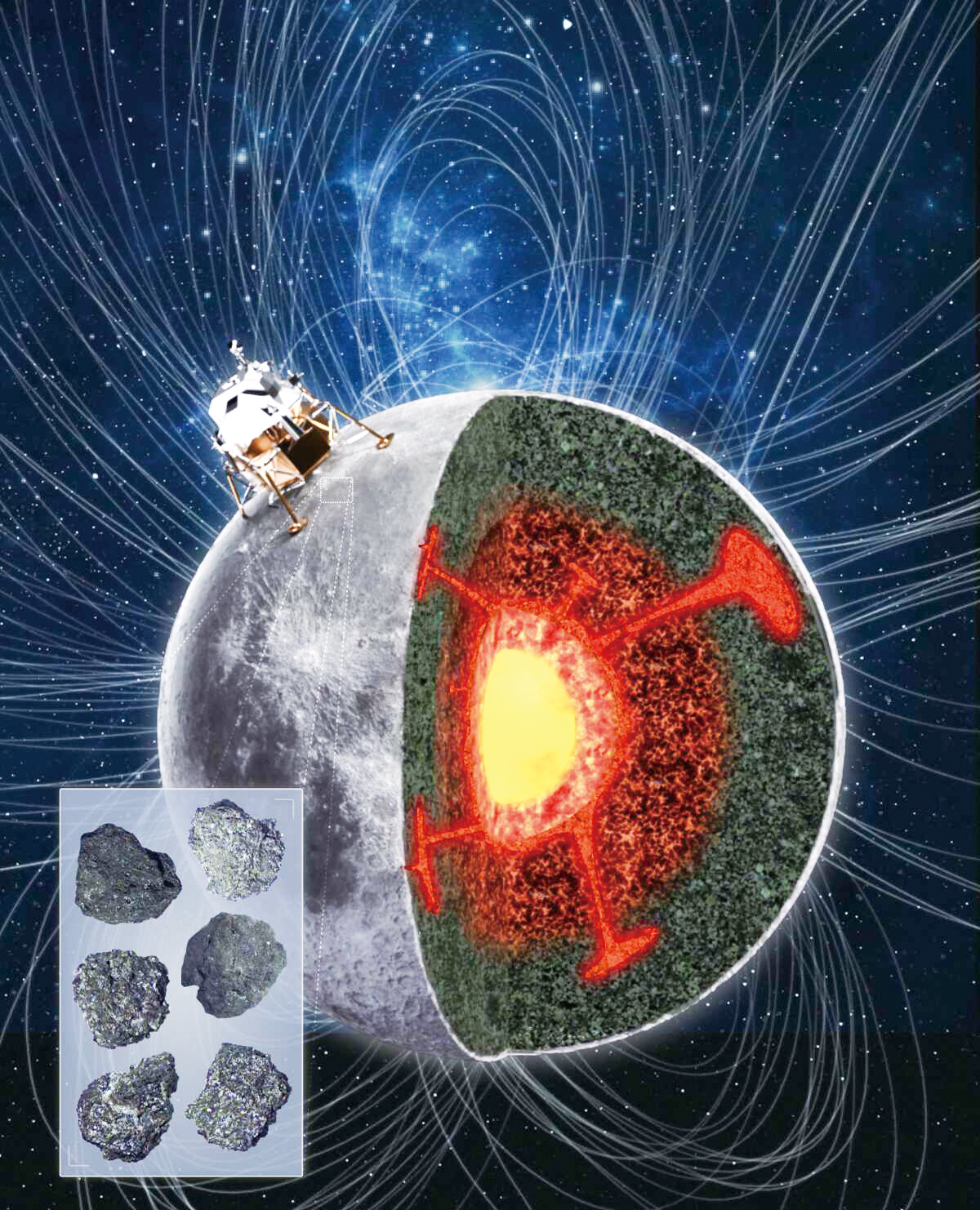
Samples brought back by CE-5 indicate that about 2 billion years ago, there might exist a weak magnetic field produced by a lunar dynamo. (Image by IGG)
Determining the Age of SPA Basin
The SPA basin, where CE-6 successfully collected lunar samples, is a legacy of a colossal meteorite impact. Studying the geological compositions and evolution of the basin can help us understand the early evolution of both the Moon and the Earth, or even provide insights into the early dynamics of our Solar System. For over half a century, scientists have struggled to precisely determine the age of this largest lunar impact basin. Samples from the Moon’s nearside have helped scientists fix a chronology model to estimate its age; however, due to the absence of in situ data from the farside, various estimates were left unverified, until the groundbreaking acquisition of CE-6 samples from the SPA basin.
A team led by Prof. CHEN Yi from IGG conducted comprehensive petrology, geochemistry and chronology analyses of the norite components within CE-6 samples, and reported their findings in National Science Review on March 21, 2025. They concluded that the SPA basin was formed about 4.25 billion years ago — just about 320 million years after the formation of the Solar System. This timing corresponds to a cataclysmic collision event that created this immense lunar structure. The determined age aligns with the cratering chronology calibrated by nearside samples, indicating a global consistency between the two hemispheres in terms of early lunar impact history.
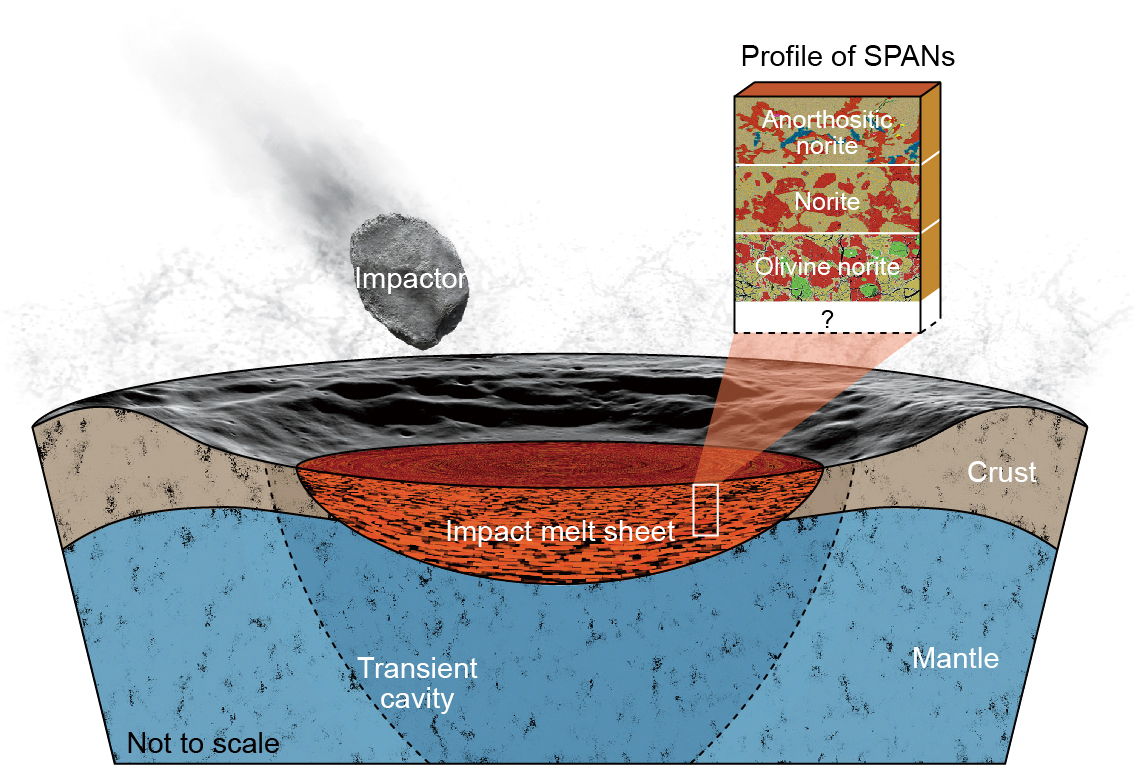
Based on their analyses of the norite clasts from the CE-6 samples, a team from the CAS Institute of Geology and Geophysics reconstructed the episode occurring 4.25 billion years ago when the huge impact produced the big crater as later named South Pole-Aitken (SPA) basin. The acronym SPAN represents “SPA norites”, a type of norites characteristic to the basin. (Image: IGG)
This result could lay an original anchor on the early history of large-scale impact events in our Solar System. Inner Solar System bodies all experienced intense impacts in their early time. As the Earth’s only natural satellite, the Moon preserves this violent heritage through its ubiquitous impact scars. The formation of the SPA basin, the biggest “scar” on the Moon, marks a critical node of this evolution, and its accurate dating can help calibrate the cratering chronology of the Solar System.
The team’s analysis indicated that the mineral constitution of the examined norite fragments are similar to those from the nearside, but vary in the mineral compositions. The distinct ingredients define them as a new type of lunar norite named “SPA norites (SPANs)”.
With the above discoveries, scientists might have just unveiled the tip of an iceberg — How different could the farside be? Following CE-6, we will know more.
Reference
Benjamin P. Weiss. (2025) The Moon goddess’s magnetic midlife. Science Advances 11, eadu7441. DOI:10.1126/sciadv.adu7441
Cai, S., Qi, K., Yang, S. et al. (2024) A reinforced lunar dynamo recorded by Chang’e-6 farside basalt. Nature. https://doi.org/10.1038/s41586-024-08526-2
Cai, S., Qin, H., Wang, H. et al. (2025) Persistent but weak magnetic field at the Moon’s midstage revealed by Chang’e-5 basalt. Science Advances. 11, eadp3333. https://doi.org/10.1126/sciadv.adp3333
Cui, Z., Yang, Q., Zhang, Y. et al. (2024) A sample of the Moon’s far side retrieved by Chang’e-6 contains 2.83-billion-year-old basalt. Science 386,1395-1399. DOI:10.1126/science.adt1093
Li, C., Hu, H., Yang, M. et al. (2024) Nature of the lunar far-side samples returned by the Chang’e-6 mission, National Science Review, Volume 11, Issue 11, nwae328, https://doi.org/10.1093/nsr/nwae328
Su, B., Chen Y., Wang, Z. et al. (2025) South Pole–Aitken massive impact 4.25 billion years ago revealed by Chang’e-6 samples. National Science Review, nwaf103, https://doi.org/10.1093/nsr/nwaf103
Zhang, Q., Yang, M., Li, Q. et al. (2024) Lunar farside volcanism 2.8 billion years ago from Chang’e-6 basalts. Nature. https://doi.org/10.1038/s41586-024-08382-0

